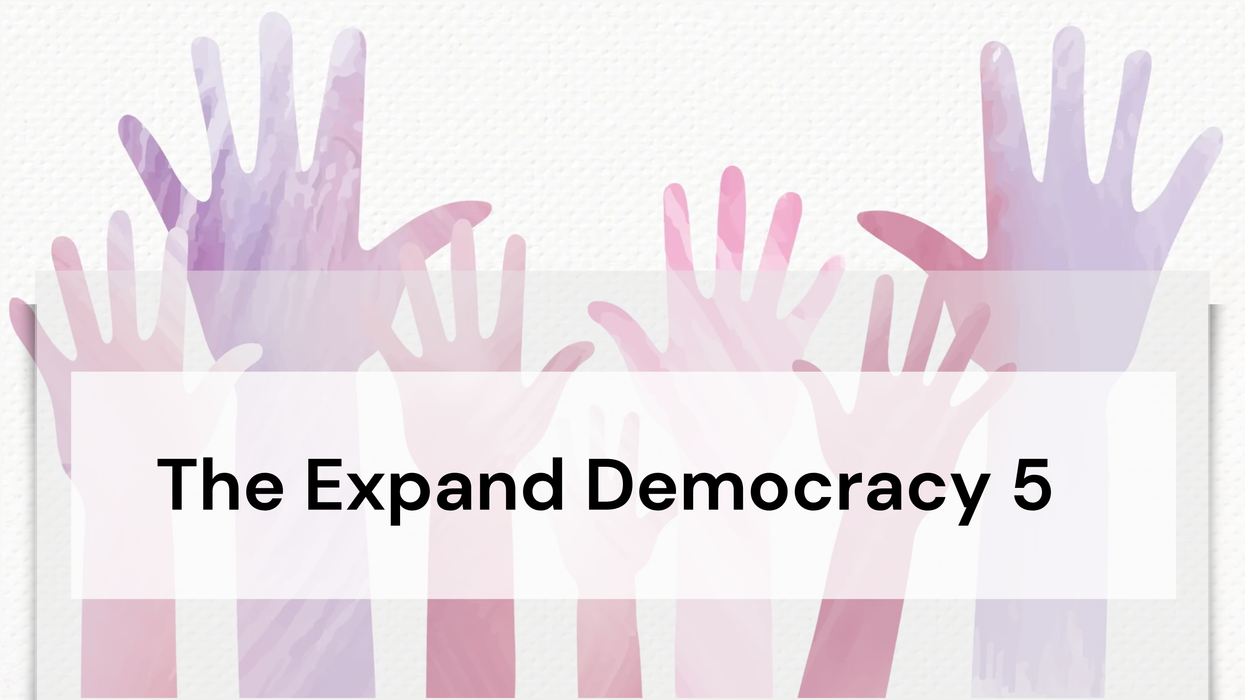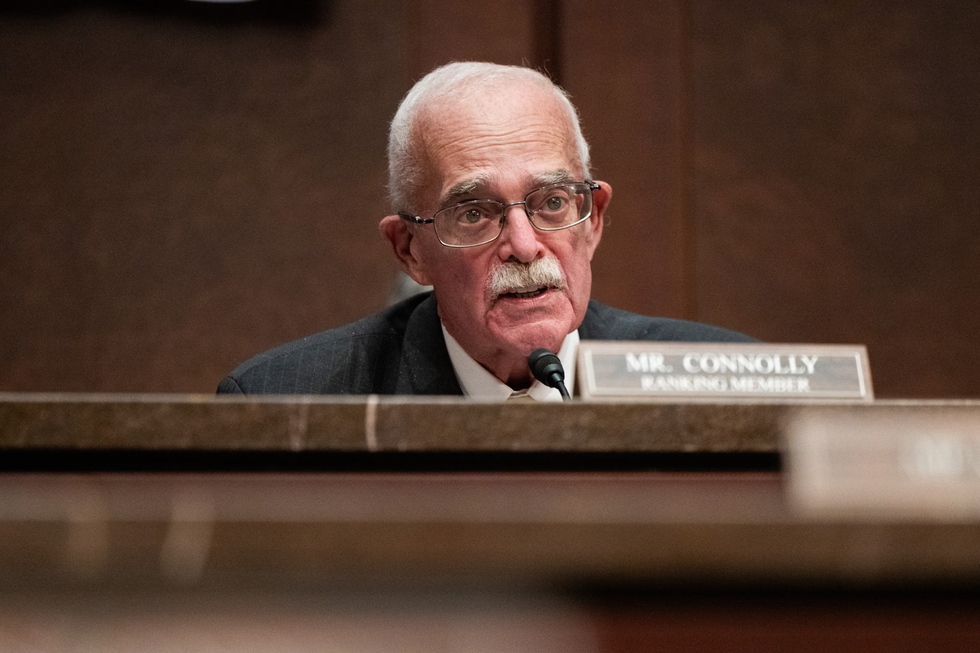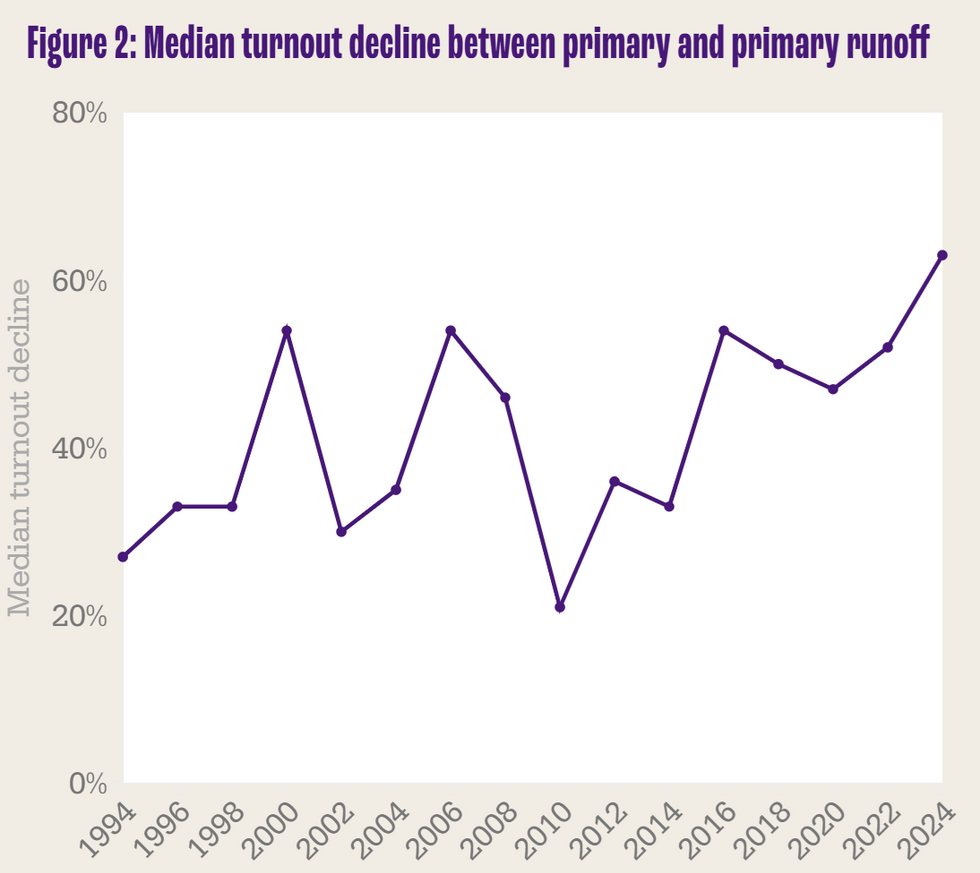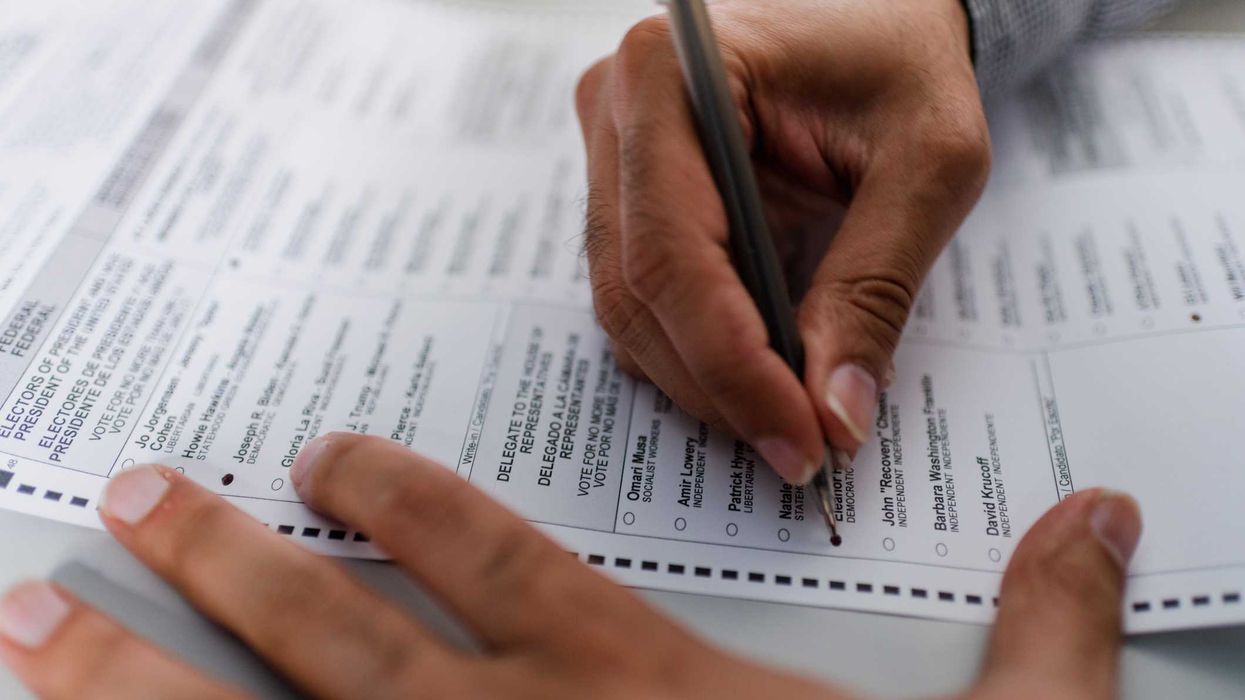Welcome to the latest edition of The Expand Democracy 5. From Rob Ritchie, with Eveline Dowling’s help, we explore five ways democracy is evolving—locally, nationally, and globally. Today's stories include:
🌟 Future of RCV is Bright - Energy & trends favor voter choice
🧒 Engaging Young People - State capital visits, mock elections, student school board members, and more
💡 Better Ways for Parties and Legislators to Pick Leaders - Combining the old and the new
⚡The Case for Faster Runoff Elections - Balancing voter access and voter energy
🕓 This Week’s Timely Links - Free press, judicial elections, social media, weak plurality winners, new RCV support
In keeping with The Fulcrum’s mission to share ideas that help to repair our democracy and make it live and work in our everyday lives, we intend to publish The Expand Democracy 5 in The Fulcrum each Friday.
If you want to suggest a pro-democracy idea for coverage in The Expand Democracy 5, please use the contact form at Expand Democracy.

Future of RCV is Bright - Energy and trends favor voter choice 🌟
Dubbed “Mr. Ranked Choice Voting” by Andrew Yang in his podcast with me in 2022, I’ve gotten a lot of questions about the future of the movement for ranked choice voting (RCV). Last year, RCV on its own lost on the ballot in Oregon. RCV’s pairing with all-candidate primaries was upheld in Alaska, but that reform package lost in Nevada (by 6%), Colorado (by 7%), and Idaho (by a landslide). Following the 2022 lead of Florida governor Ron DeSantis, 16 Republican-run states have performatively “banned” RCV - and while no such “ban” stopped a current use of RCV, it signaled partisan opposition after years of RCV earning support across the partisan spectrum..
I’m as disappointed with these setbacks as any backer of RCV, but my optimism for America’s eventual shift to RCV - and more broadly, to redefining voting as ranking – is as high as ever. Eveline, Cynthia Richie Terrell, and I are working on a book to be published next year where we’ll lay out the case for that change, and I wanted to share a few toplines about where we are:
- Americans aren’t satisfied with limited voter choice: The data is overwhelmingly clear, both domestically and internationally, that a two-choice political system is unsustainable today. Younger Americans, in particular, will not accept being so limited – and notably, RCV would have won in several states last year if all voters had been under 50, while student government leaders at more than 100 colleges are elected with RCV. Other valuable reforms, such as proportional representation, provide greater choice, but the RCV ballot uniquely serves as a straightforward tool to accommodate greater voter choice across a full range of offices. RCV is also an ongoing inspiration to activists, like those supported by Rank the Vote and RepresentWomen. Fundamentally, RCV ballots strengthen our right to vote by empowering voters to ensure their voices are heard and ensuring confident candidates achieve the outcomes their support warrants.
- RCV is working in practice - and implementation will keep improving: RCV has an increasingly well-established track record, as FairVote summarizes with its data on RCV elections. An average of nearly one-third more votes determines the winner in the hundreds of RCV races decided in instant runoffs. On average, mayoral winners receive affirmative support from around two-thirds of voters, voter errors affecting valid ballots are minimal (less than 0.4%), and a majority of voters approve of it after voting in RCV races. With a boost from groups like the RCV Resource Center, we are getting close to where we will most certainly arrive: RCV results that are as transparent, auditable, and fast as non-RCV elections.
- Advocacy for big change is rarely linear: There is a certain rhythm to significant change efforts. At first, RCV advocacy was perceived as marginal, facing little scrutiny and limited pushback. It then experienced a surge of support after its trailblazing state win in Maine in 2016, and that momentum carried for years. But success breeds opposition. Such opposition doesn’t mean you will lose; it simply means you must work harder. Some Republican activists, in particular, saw an opportunity to tap into grievances about outcomes they didn’t like in Alaska and Maine, but other Republicans view RCV as beneficial for both their party and all voters.
- The state measures were rushed, while RCV keeps winning in cities: FairVote’s RCV advocacy has been most focused on winning in cities and developing legislative and party-backed paths toward RCV. That strategy continues to show great promise – several cities and counties have legislatively adopted RCV, while RCV has succeeded in 31 of the last 32 ballot initiatives, including a commanding 73% victory in Washington, DC, last year, which will transition DC elections for president and other offices to RCV by 2028. State adoptions are truly exciting, and I understand the desire to accelerate them, but in retrospect, recent ballot measure efforts were premature. In fact, no significant structural changes were approved on the ballot in 2024, including “Top Two” primary measures that were defeated by a landslide in Arizona and South Dakota. When changing elections in ways that aren’t immediately intuitive to all voters, it is beneficial to take extra steps to prepare the community, reassure voters by securing more community support, and finalize all implementation details—ideally twinned with additional local and legislative victories.
- Congress can act to pass RCV in all 50 states: Once the implementation details are finalized and the track record is even more impressive, I expect Congress to embrace its historic role of learning from our state laboratories of democracy and make RCV the standard for congressional elections. This includes potentially supporting the transformative Fair Representation Act, which could have a ripple effect on everything else on the ballot. That won’t happen tomorrow, but I could see it happening within a decade.
To be clear, I’m not calling the shots for future RCV advocacy, but am an advisor to groups like FairVote that do. I’m impressed with the RCV movement’s leadership and confident that we’ll have much good news to share on RCV for years to come.


Engaging Young People - State capital visits, mock elections, student school board members, and more
As we experience declines in democratic institutions across the world (with average declines in democracy ratings every year of this century, according to Freedom House), it becomes all the more imperative to invest in our young people as they go through our K-12 education system and enter their adult role as governing citizens. Some nations, like Sweden, take this exceptionally seriously, offering year-long civic education classes in the spirit of “driver’s ed.” These classes include trips for every student to the national capital to participate in a mock parliament and see the actual parliament in action; American civic education lags.
There are some great groups working to address what can be done. Founded by former Supreme Court Justice Sandra Day O’Connor, ICivics has an ambitious vision. Citizen University brings together a range of key civic players. For examples of ideas that earned my support over the years, here are four from FairVote’s blog and old policy guide:
- Mock Legislatures in Capitol - “The best way for students to understand how their elected officials pass laws is to participate in a mock legislative session…One successful program is Utah 4-H’s mock legislative debates, which take place in the Utah House Chambers. Students travel from across the state to take a tour of the Capitol building, hear guest speakers discuss the legislative process, meet in their own assigned committees to discuss legislation, form their own rules committee to decide in what order legislation will be presented, and debate 15 bills before voting on the House floor.”
- High School Civics Education: “In a 1996 study conducted by the National Center for Education Statistics, 37% of American adults said that they believed that politics and government are too complicated to understand. Since this study, however, civics assessment scores have remained the same or declined… Increasing access to civics education will improve youth engagement in our political system ....One California survey found students who participated in civics were almost twice as likely to report interest in politics.”
- Mock Election to Introduce Voting: “A mock election is an election organized for educational or transformative purposes. Most of the time, they are organized by secondary schools to introduce young people to the different ideals and conceptions of democracy before they become eligible to vote. The elections are designed to give the students a better understanding of democratic institutions like Congress or local government, and help prepare them for their role as voters, ideally stimulating future young voters to use their vote. Founded in 1988, Kids Voting USA seeks to introduce students to concepts of citizenship in the earliest grades and continue throughout their school years, with a particular focus on mock elections.”
- Student Voters and Representation on School Boards: “The Board of Education of Montgomery County Public Schools in Maryland began its Student Member of the Board (SMOB) program in 1978. The SMOB is a high school student in Montgomery County who is elected by all high and middle school students (6th through 12th grade) in the county, using the same voting equipment the county uses for its federal and state elections. High school student leaders narrow the number of SMOB candidates to two candidates to face student voters, and the candidates then publicize their resumes and take part in an aired question and answer session viewed by student voters. The SMOB holds his or her position for one year. That means Montgomery County Public School students who attend county schools from 6th through 12th grade have had a chance to vote in six elections by the time they graduate, using the exact same voting equipment used for all countywide elections.”

Better Ways for Parties and Legislators to Pick Leaders - Combining the old and the new 💡
Last week, Virginia Congressman Gerry Connolly tragically died of cancer. A special election will be held to fill his House seat later this year, while Politico reports that on June 24th, the Democratic caucus in the House will hold a vote to fill the ranking Democrat on the Oversight and Government Reform Committee that, “is shaping up to be a competitive four-way race that could test Democrats’ adherence to their seniority system for committee leadership and appetite to elevate younger members. Reps. Jasmine Crockett of Texas, Stephen Lynch of Massachusetts, Kweisi Mfume of Maryland, and Robert Garcia of California are all expected to run for the position.”
In 2022, House Democrats nearly enacted a rule change to hold such caucus elections with ranked choice voting. Recommended by Robert’s Rules of Order as an alternative to a series of single-choice elections until a candidate secures a majority of the vote, RCV is widely used by private organizations and parties. It encourages voters to consider all their options in ways that align with a desire for more collaborative, consensus-driven leadership. Already, a number of Democratic state parties have turned to RCV for internal elections, including party chair elections in Wisconsin and Iowa.
RCV works well in such settings, but it may not come with as much deliberation and negotiation as with multiple rounds of voting. When voters gather in person for a significant internal election, such as selecting a national party chair, a presidential nominee at a convention, or the Speaker of the House, I recommend striking a balance between straightforward RCV and multiple rounds of voting. An example would involve starting with two or three single-choice voting rounds, which would allow voters to see where the candidates stand, engage in discussion and negotiation between rounds, and then “call the question” with a binding RCV election. That approach would allow time to identify compromise choices where needed, but it would still benefit from how RCV encourages both voters and candidates to engage beyond their first-choice support.
Calling the question can also be very important. In 1924, national Democrats held 103 rounds of voting to pick a presidential nominee, adding days to their convention. In 2023, Congress was put on hold for four days while Republicans sought to elect a Speaker of the House over 15 rounds of voting. Combining a few rounds of voting with a decisive vote utilizing RCV would limit delays and diminish the influence of those primarily aiming to obstruct outcomes rather than contribute to them.

The Case for Faster Runoff Elections – Balancing voter access and voter energy ⚡
Guest-blogging for Rick Hasen’s ever-valuable election law blog, Loyola law professor Justin Levitt lifted up news coverage from the Massachusetts city of New Bedford on the challenges of holding a winnowing primary and general election four weeks apart, terming that turnaround time a “horrible idea.” With full respect for Justin and great empathy for the pressures on election officials, I want to push back against the idea that longer gaps between runoff rounds are better for democracy.
The reality is that longer gaps between rounds are worse for voter turnout. University of Georgia professor Charles Bullock has a new manuscript on runoff elections that builds on his impressive academic work on this issue. It can’t reach the public too soon, as how we conduct runoff elections is an important question – not only in the nine states using runoff elections in their primary and/or general elections, but also in many major cities and in states that may vote on variations of California’s Top Two primary model and Louisiana’s all-candidate election model. A teaser from Bullock’s forthcoming book reveals that among the runoffs he studied, voter turnout declined by 12% on average in the 1,234 runoffs where the runoff period was less than four weeks. For the 879 runoffs where the runoff period was exactly four weeks, the average decline was over 26%. For the 590 runoffs where the runoff period was more than four weeks, the average turnout decline was nearly 40%.
FairVote has identified similar patterns in its important report on all 294 congressional primary runoffs held between 1994 and 2024. It found turnout decreased from the primary to the runoff in 97% of contests by a median of 41%. In 2024, the pattern was even more stark, with turnout declines in all 16 runoffs, with a median decline of 63% and with fully 81% of winners receiving fewer votes in the runoff than in the first round.
FairVote also affirms the influence of runoff time, with author Rachel Hutchinson writing: “Since 1994, runoffs held within 30 days of the initial primary had a median turnout decline of 33%, while those with a gap greater than 30 days had a median decline of 48%.” Notably, the 2024 runoff with the smallest decline (still high at 32%) was in South Carolina, where the runoff period is just two weeks, based in part on having its overseas voters cast instant runoff ballots. This turnout difference based on time intuitively makes sense. A faster runoff makes the two rounds of voting feel more like a single contest. Imagine if the gap between National Football League games were six weeks rather than one, or the impact on ratings if a TV show’s final annual episode premiered two months after its previous episode.
As we examine election reforms, I’m an obvious fan of ranked choice voting, or “instant runoffs." However, for states and cities that have two rounds of voting, discovering ways to merge them into a single, engaging election session is highly appealing. Notably, it’s quite common overseas, such as the two-week runoff for France’s presidential elections ( where in 2022, the turnout was 73.7% in the first round and 72% in the runoff) and the two weeks needed for Romania’s recent presidential runoff, where turnout surged from 53.2% to 64.7%. Exploring how to keep the runoff period under a month is worth the effort.

Timely Links - Free Press, judicial elections, social media, weak plurality winners, new RCV support
We close The Expand Democracy 5 with notable links:
- A Free People Need a Free Press: New York Times publisher A.G. Sulzberger has a powerful defense of journalism and a warning for unprecedented attacks underway on the press from the Trump administration. He concludes: “As the free press and democracy more broadly face this period of pressure, I’d urge you to support both by seeking out news sources worthy of your trust. News sources that produce original, independent reporting in the public interest and that have a record of challenging power, no matter who wields it. Make room for this kind of journalism in your lives and routines. Read. Listen. Watch. Engaging with the news is one of the simplest, most essential acts of citizenship. This is not the time to tune out.”
- Mexico to Hold First Judicial Elections: From the Associated Press: “Mexicans will vote in the country’s first judicial elections Sunday. The fiercely debated question is whether electing judges will deepen democratic decay or purge courts of rampant corruption and impunity…Watchdogs also say that last year’s vote on the reform was rushed through, criteria for candidates wasn’t always followed, the number of candidates was limited by a lottery and lower-court orders trying to keep the reforms from taking effect were ignored.”
- Montana Moves to Cement Nonpartisan Judicial Elections: KTVH reports on how Montana has long held nonpartisan judicial elections, but recent legislative efforts have aimed to introduce party labels. In response, a new ballot initiative seeks to enshrine nonpartisan judicial elections in the state constitution. Its advocates argue the measure supports judicial impartiality and public trust in the legal system.
- The Plurality Problem: Plurality Primary Victors Hurt Parties in General Elections: Rachel Hutchinson and Laurel Harbridge-Yong have an updated paper at SSRN where they “examine U.S. House, U.S. Senate, and gubernatorial partisan primaries from 2010-2022 in which three or more candidates ran. [They] find that plurality primary winners underperform and that in competitive districts, this translates into a reduced likelihood of winning the general election.”
- Social Media & Democracy at Notre Dame: Notre Dame hosted a national convening this week, bringing together lawmakers, tech leaders, and scholars to tackle the growing impact of social media on democracy. With a focus on misinformation, polarization, and policy solutions, the event is part of a broader push to build a healthier digital public square.
- Candidate for NJ Governor Steven Fulop calls for ranked choice voting: Jersey City Mayor Steven Fulop and Democratic candidate for governor via X/Twitter (5/24) writes, “This election is about the future of NJ. Will it be a state run by insiders or one accountable to ppl who live here. Ranked Choice Voting is key to putting power in the hands of voters. We stand alone that we’ll fight to make RCV happen in NJ. Join us!”
- It’s Time For Conservatives To Embrace Ranked Choice Voting: Townhall columnist Scott Morefield concludes his columns with “It’s time to put an end to the nonsense. Republicans, especially the populist version under Trump, are the majority party with majority ideas. If we run with ranked choice voting, we win. Just ask the New York City Council members who are about to be forced to debate one of the sharpest MAGA voices in the city.” (Watch May 28th charter commission testimony on nonpartisan elections with RCV from that MAGA voice Frank Morano.)






















